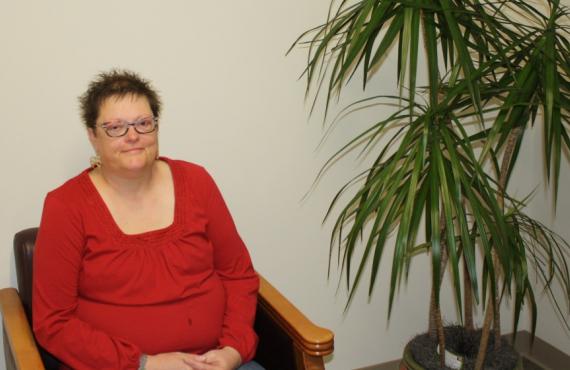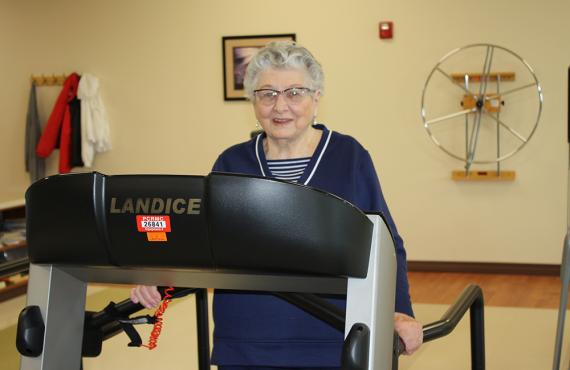Published on September 22, 2021
Read Time: Seven Minutes
Candy Sadler, AGNP, WOCN, who specializes in wound and ostomy care at Phelps Health, talks about how healthy living relates to wound care. Candy is an adult-geriatric nurse practitioner (AGNP), who sees patients in the Phelps Health Wound Center.
How did you become interested in wound care?
“My mom had an open wound, when I was a teenager. [She had] an abdominal wound and an ostomy, so I learned a lot about that as a young person. When I was…with her in the hospital, I got to go in. I got to see them [healthcare workers] do the wound care dressing, change the ostomy pouch, and I got to learn about that. And it was really interesting to me. I just thought it was fascinating.”
What are wound, ostomy and continence care?
“Wound care is basically [caring for] any wound that just won’t heal by regular means [and is] stuck in the inflammatory phase [after three months]. It [timeframe of three months] could be sooner if you have a lot of debilitating conditions.
“Ostomies are when you have to re-route your bowel. Typically, you wear a pouch. We teach people how to take care of that [and] any complications from that.
“Continence [refers to] any type of bowel or bladder continence issues (ability to control movements in the bowel or bladder). Typically, it’s more continence issues with urostomies (surgeries to reroute urine away from the bladder) and things like that, if I do get involved.”
What can patients expect during an initial visit to the Wound Center?
“We do our initial assessment. We find out why you have this wound [and] what are the factors [that caused the wound]. Typically, we see a lot of [wounds due to] diabetes, so we want to make sure their [patients’] blood sugars are under control [and] they're working with their doctor to get that taken care of. Then, when we find out the ‘why’ of the wound, we try to fix that either socially, functionally or health-wise.”
How does wound care relate to healthy living?
“Mostly, I like to think of us [Wound Center staff] as a small portion of a patient's life. We're kind of an ancillary (providing necessary support); you don't have us forever. Every single appointment, we want to make sure that we're helping out their [patients’] primary care doctors, and especially for diabetic patients, their podiatrist, by teaching them nutrition; good, healthy eating habits; and how you heal a wound.
“How you heal a wound is similar to bodybuilding. You're breaking down your muscle tissue and you're rebuilding it to create bigger muscles. With wound care, you have broken down tissue and you need to rebuild it to heal.”
What parts of nutrition play a role in our health? Do wound patients need to change their diets?
“It [healing wounds] very much comes down to nutrition and what you're eating. If you're not giving the good nutrition to your body, you're not going to heal.
“Carbs, protein and fats are extremely important for wound healing, especially protein. A lot of people are not quite getting enough protein. It's pretty uncommon knowledge that as you age, you actually need to increase your protein. So, in order to combat what we call age-related sarcopenia, which is age-related muscle loss, increasing your protein and making sure you're getting enough of that for wound healing [and] muscle building [is important]. You can build muscle as you age.
“A lot of people think, ‘Well, I’m just getting older and my metabolism is slowing down.’ What’s really slowing down is you’re losing muscle mass. In order to combat that, in order to continue keeping your muscle mass, or even building [muscles] in some cases, you need to make sure your diet is adequate.”
Is muscle loss preventable as you age?
“[Muscle loss is] somewhat preventable. [It’s] certainly not completely [preventable], but you can certainly slow it down. For a lot of people, if you're really starting out [with training and are] brand new to it, you can…lose weight, lose body fat and gain muscle at the same time. Once you're fairly well-trained…it levels out, but newly trained individuals can actually increase their muscle mass and reduce their body fat levels and [change] their whole body composition.”
How can wound and ostomy care patients be more active?
“I became active with my friends. We decided to start working out…We started an at-home workout…and we just kept getting stronger. It was fun, and it just progressed from there. Studies do show this. When you're accountable to someone, you do things that you like to do.
“A patient of mine -- he was in his late 80s, early 90s -- came to the Wound Clinic…and he would play racquetball as a retired person with his friend three days a week. They would just go have fun and play racquetball, and that is a very good example of healthy exercise, but not really thinking of it as exercise.
“Walking your dog, getting outside [or] going to a gym together with your spouse [are] wonderful [ways to be active]. There are tons of programs out there, and there are really inexpensive gyms to join if you don't like walking outside.”
Can drinking water help with wound healing? Does drinking regular or diet soda affect how quickly wounds heal?
“Everybody needs to be hydrated…If you're drinking your calories, that is more of a concern or an issue. What are people drinking? Are they drinking lots of soda? Can we switch to lower-calorie options? I prefer diet soda because it has less calories.
“Fluid levels are what's really important. I was looking at a statistic the other day that said [in] a normal diet, we get about 20% of our fluid just from our food. If you're one of those people [that say] ‘I just am never really thirsty, and I just have to make myself drink,’ that’s fine. I'm like that. I used to have to make sure that I was drinking enough, and I monitored it. But a lot of people are thirsty, and they can [tell if they’re dehydrated] pretty much by thirst.”
How does the Wound Center staff stay healthy and active?
“We all pretty much stick to a healthy diet when we're together. I did a bodybuilding competition…with one of my nurses. Another one of my nurses and I work out all the time together. Another one of my nurses…she does at-home workouts on video. We all live this healthy lifestyle mostly.
“We want our patients to see that you can have kids and have a job and still be active and have fun, because it's really actually just fun for us.”
How can you eat healthy and stay active on a budget?
“It [staying healthy] can be expensive. Convenience is expensive…It's convenience that you pay for, so I do feel like people can put their money into things of convenience and then save other places. [For example] vegetables can be grown [and] can be canned…My parents have a garden. They give me tomatoes…I don't have to buy them.”
Do you offer advice to your patients regarding diet changes?
“I leave that more up to their primary care doctor, [or] diabetes education sees a lot of my patients, too. What I like to do is…give them real, sustainable things [they can change]. [While we are performing a wound dressing change, we can] discuss healthy eating options. It's really helpful for us to be doing it [eating healthy] because we can then teach it [to our patients].”
Learn About Wound Care
For more information about the Phelps Health Wound Center, call (573) 426-2214.

